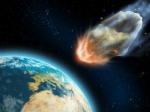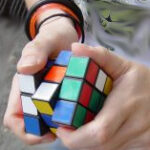
March 7, 2013
Should You Worry About Asteroids?
During Lyta’s time (the Plio-Pleistocene, around 1.8 mya), Nature was more violent than today. Africa’s volcanics were more common and more violent. Mt. Ngorongoro was still alive and belching smoke, as were its many neighbors, possibly due to the growing Great African Rift (the same one we predict will eventually tear the continent in two). Thanks to the triptych of faults (East Africa sits at a rare intersection of three tectonic plates), Earthquakes shook her terrain. The land was cooling, shedding the rainforests her ancestors enjoyed and adopting the grassy savannas still prevalent today.
And, unfortunately for Lyta, an asteroid hit Earth at the same moment a monstrous volcano erupted. Modern

scientists agree there is no imminent threat of Earth being bombarded by an asteroid like the one they suspect killed the dinosaurs 65 mya. They also agree we will eventually be hit. The average: about every 100,000 years, we get a bad one. Scientists also agree we have no reliable method of stopping them. Lasers. Nuclear weapons. Nudging them out of the way. They all have their problems.
Lyta lived 1.8 mya. It was her bad luck it was during that once-in-a-hundred thousand years year, and more bad luck–during a volcanic eruption. This confluence of bad luck challenged her nascient human problem-solving skills: She was separated from her infant son, her mate and on the run from that vicious future human, Homo erectus. You can see why I kept Otto focused on her life. Did mankind have the skills as the earliest of the Homo species to solve this sort of multi-problem?
As background for you, I copied this from NASA, to give you an idea how seriously we take potential asteroid impacts:
Potentially Hazardous Asteroids (PHAs) are space rocks larger than approximately 100m that can come closer to Earth than 0.05 AU. None of the known PHAs is on a collision course with our planet, although astronomers are finding new ones all the time.|
|
|
|
| Asteroid |
Date(UT)
|
Miss Distance
|
Mag.
|
Size
|
| 2009 KR21 |
June 1
|
0.7 LD
|
16
|
21 m
|
| 2009 KL8 |
June 1
|
5.1 LD
|
18
|
63 m
|
| 2003 QO104 |
June 9
|
36.8 LD
|
14
|
2.9 km
|
| 1994 CC |
June 10
|
6.6 LD
|
13
|
1.2 km
|
| 2009 MU |
June 24
|
2.3 LD
|
17
|
54 m
|
| 2001 FE90 |
June 28
|
7.0 LD
|
13
|
435 m
|
| 2002 KL6 |
June 28
|
57.5 LD
|
16
|
1.4 km
|
| 2006 MV1 |
June 30
|
9.6 LD
|
23
|
20 m
|
|
|
Jacqui Murray has been teaching K-8 technology for 15 years. She is the editor of a K-8 technology curriculum, K-8 keyboard curriculum, K-8 Digital Citizenship curriculum, and creator of technology training books for how to integrate technology in education. She is the author of the popular Building a Midshipman, the story of her daughter’s journey from high school to United States Naval Academy. She is webmaster for six blogs, an Amazon Vine Voice book reviewer, Editorial Review Board member for Journal for Computing Teachers, presentation reviewer for CSTA, Cisco guest blogger, a monthly contributor to TeachHUB, columnist for Examiner.com, featured blogger for Technology in Education, and IMS tech expert. Currently, she’s editing a techno-thriller that should be out to publishers next summer. Contact Jacqui at her writing office or her tech lab, Ask a Tech Teacher.






